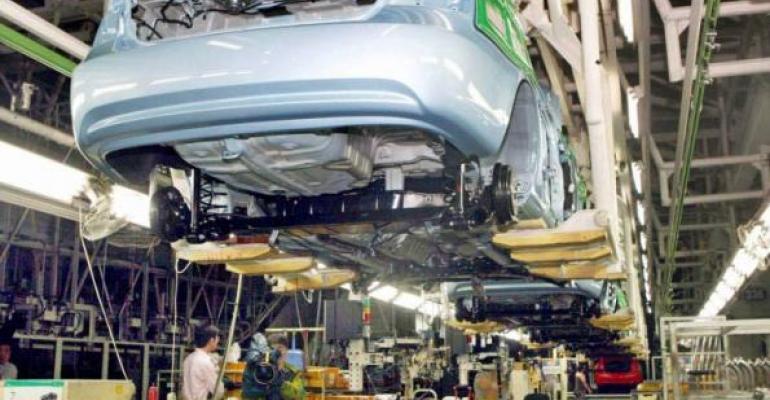The union representing Hyundai workers in South Korea does an about-face, announcing it will stage partial strikes in the absence of a new contract.
Union leaders did not announce plans for a strike after 66% of members who cast ballots voted July 14 to authorize a walkout.
The president of the Hyundai Branch of the Korean Metal Workers Union had announced July 19 the union would continue to bargain with management in good faith in hopes of securing a tentative contract before the traditional summer holiday, which is to begin Aug. 31.
But the KMWU announced Aug. 8 members would strike for four hours, two hours on each of the day and afternoon shifts, on Aug. 10 and Aug. 14. The union has conducted partial strikes in each of the past three years.
Employees also will decline all weekend work, which will cost Hyundai at least 16 hours of lost production every week in addition to production losses caused by the partial strikes.
The planned shutdowns will occur in the middle of the shifts, from 11:30 a.m. to 1:30 p.m. on the day shift, and from 8:20 p.m. to 10:20 p.m. on the afternoon shift.
While lasting only two hours on each shift, the brief shutdowns play havoc with production scheduling. All Hyundai plants operate on a just-in-time basis, receiving parts and modules from other plants or from in-plant module production lines operated by outside suppliers on hours different than those of the vehicle-production lines.
“The company will continue to have sincere discussions with the union to resolve the issue as early as possible,” a Hyundai spokesman tells WardsAuto.
When asked for comment, the Ulsan office of the KMWU hung up the phone.
Neither party has disclosed the number of negotiation meetings that have been held.
The union has not budged in its demands, which were set by the central headquarters of the KMWU.
The wage increase demand is the same for both Hyundai and its affiliate Kia Motors: A 154,883 won ($138) average monthly wage increase that is a little more than a 7% raise, and bonuses calculated by dividing 30% of the company’s 2016 net income among the work force.
The Hyundai union also is seeking elimination of one hour from the 9-hour afternoon shift, with no offsetting drop in pay. It also wants management to change the pay system from an hourly to a salary basis, and sign employment guarantees that provide a set level of worker income regardless of production schedules or the impact of automation or other improved production methods.
Strike Talk No Surprise to Industry-Watchers
Virtually all analysts had discounted the union’s sincerity in making the July 19 good faith bargaining announcement. They anticipated the union would announce strike action following the traditional holiday shutdown.
Many analysts believe the union merely was lying low for a few extra days to escape public condemnation for hitting Hyundai with strikes while it is in its present dire straits.
The union knew Hyundai on July 26 would announce the disastrous impact from plunging sales in China and lesser sales declines in the U.S.
For the second quarter ending June 30 global sales were down 13.8% with 1.1 million vehicles sold. Deliveries in China for the second quarter were down 64.2% on a yearly basis, with 105,000 vehicles sold.
For the first six months of 2017 Hyundai’s global sales were off 8.2% with 2.2 million vehicles sold. Sales in China for the full six months plunged 42.4% to 301,000.
Operating profit for the second quarter continued to fall and was off 24% on a yearly basis with 1.3 trillion won ($1.2 billion) reported. Net income for the quarter plunged 51% year-on-year, dropping from 1.7 trillion won ($1.5 billion) in like-2016 to 816.9 billion won ($728.8 million).
The sales picture has worsened since: July sales were off 11.4% from June and were down 1.8% on a yearly basis with 333,180 vehicles sold globally.
For the first seven months of 2017 Hyundai’s global sales were off 7.4% with 2.53 million vehicles sold.
Hyundai’s situation in China, where it has five highly efficient plants producing at drastically reduced rates because sales levels currently are more than halved, is even getting worse.
The sales plunge has been caused mostly by a government-inspired boycott of all Korean products. This is a political move to try to force South Korea to remove an American THAAD (Terminal High Altitude Area Defense) missile system from its shores.
The administration of President Moon Jae-in, who took office just last month, had ordered a lengthy environmental review of the missile system, which would keep it from being operational for about one year.
However, in recent days Moon has come out supporting deployment of not just one but four THAAD systems. His about-face came after North Korea fired its latest intercontinental ballistic missile and began threatening the world with the use of missile-delivered nuclear warheads.
The KMWU at the end of July issued research findings that concluded the union must move beyond union-management warfare and realize the automotive industry is changing drastically.
The report notes: “Instead of focusing on short-term economic gains, unions should focus on having social dialogue for the sake of long-term employment. What used to be done by skilled workers will be replaced by automation and computers. Unions must educate and train the workforce as new technologies are adopted.”
Hyundai has suffered strikes in 26 of the 30 years since the first Hyundai Motor union was formed in 1987.





